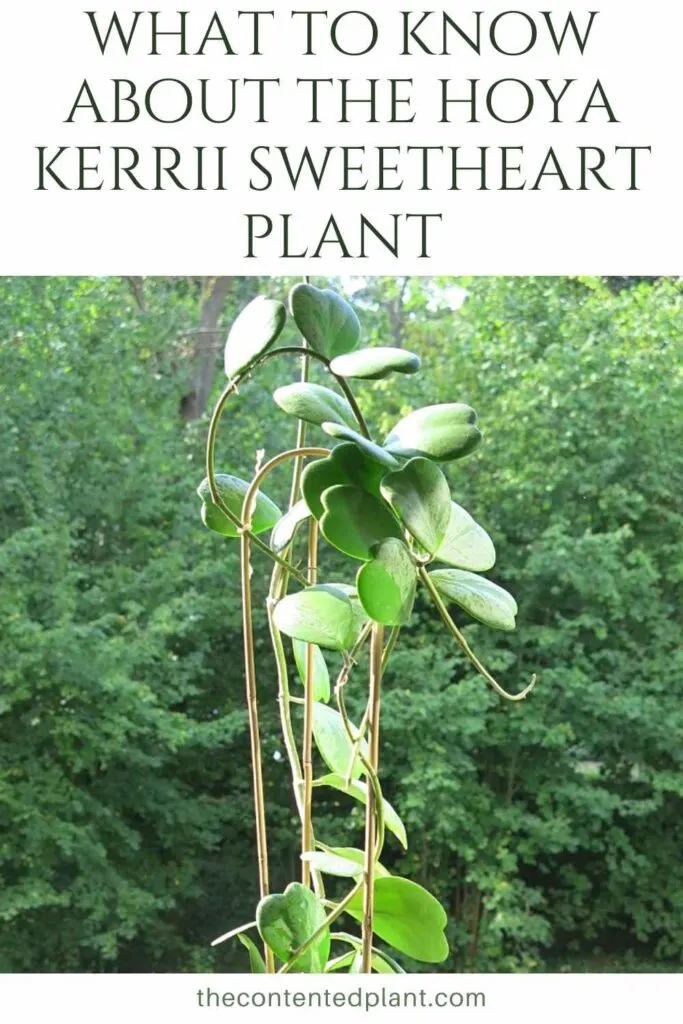The Hoya Heart plant (Hoya Kerrii) is a whimsical succulent vine with romantically heart shaped leaves. Give this plant to your bestie beginner plant parent. It’s a fun way to say ” I love you ” at Valentines Day. 🙂
This heart shaped leaf plant is native to South East Asia. They like hot humid conditions year round. The thick succulent leaves are waxy. The Hoya Kerrii is one of the wax plants.
Give it lots of humidity but NOT a lot of water. This drought tolerant plant will get root rot if you over water it.
The sweetheart vine trails and climbs to about 13 feet. You can prune it and plant the leaves to make more plant babies.
But this vine grows EXTREMELY slowly depending on conditions.
You will have several years to wait if you want a 13 foot long vine.
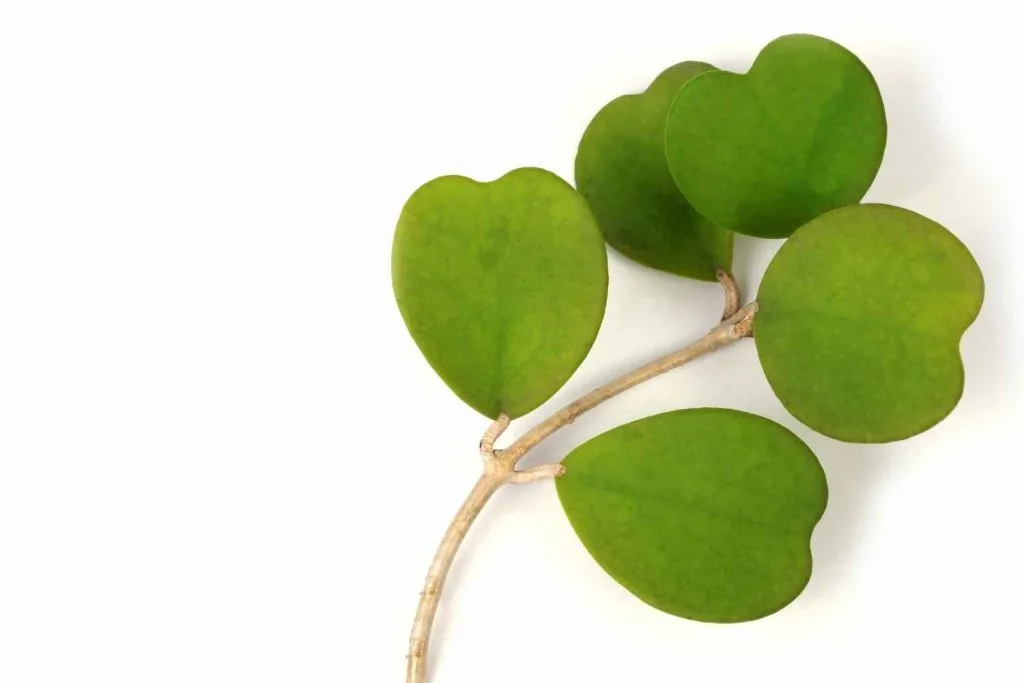
Hoya Kerrii Growth:
You can find the hoya heart plant in lots of local plant shops. They are most often sold as single leaved novelty plants in small pots. At this rate you will have quite a wait to see this vine mature and flower.
AND…the single leaves in pots are not reliable growers. Yes, They can eventually put out new growth. But do not always do so.
For a better chance at a more reliable growing hoya heart plant look for one with more foliage and vine.
It is much more difficult to find a mature plant with lots of foliage. And they are pricier. Etsy shops sell the single leaved heart plant. However, some Etsy shops will have Heart Plants with actual vining growth for you.
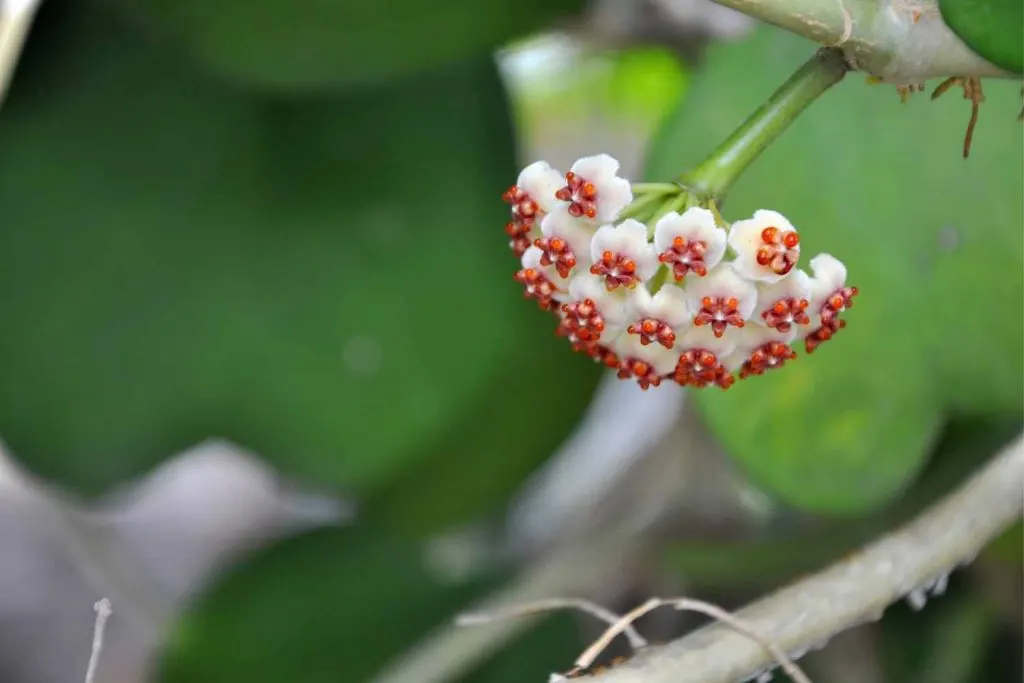
Like other Hoyas the heart plant does flower in the summer when it has optimal growing conditions.
When you see the flower spikes emerge you can expect flower clusters to form. They will be lightly fragrant.
There are several cultivars of the hoya sweetheart plant. Some are variegated. The variegated forms do need a brighter indirect light to maintain their beautiful colorings.
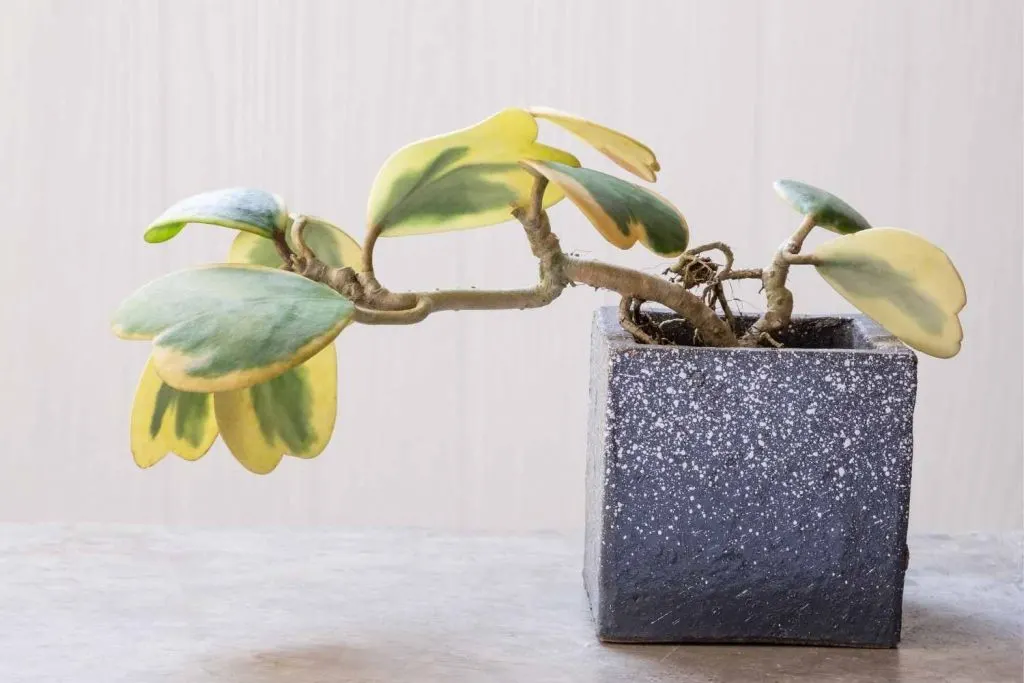
Hoya Kerrii- Sweetheart Vine care guide:
Read our complete printable care guide on Hoya care below. Hoya Kerrii’s are fairly simple to care for. Just don’t overwater them .:)
Hoya Kerrii Care Guide
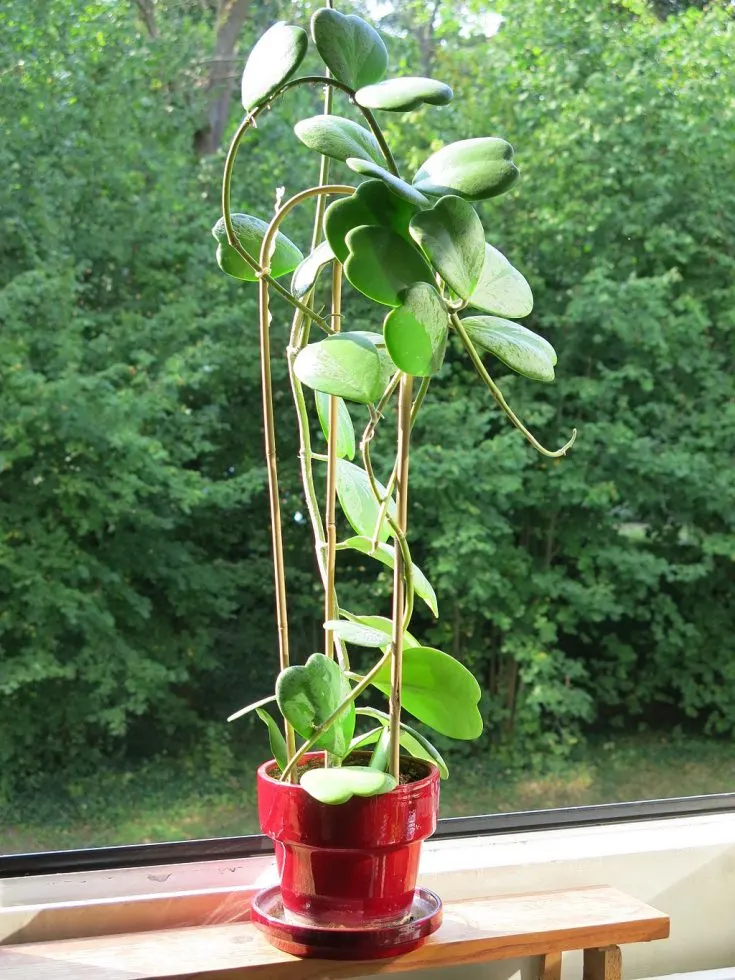
Hoya Kerri plants are slightly succulent vines with rounded heart shaped leaves. These plants have strong stems and somewhat thick waxy leaves. These are very slow growing, Fragrant, flowering vines.
SweetHeart Leaf vines enjoy trailing and can also be trellised. They grow to about four feet long.
This Hoya vine is easy care. However all hoyas are susceptible to root rot and mealy bugs. Pay particular attention to the watering needs of this plant.
Tools
Instructions
Soil Preference:
- This plant requires a light well draining soil mix. Hoyas cannot tolerate water logged soil compacted around the roots.
- A mix of potting soil, succulent soil mix and orchid soil mix (look for one with a lot of peat and finer bark mix) will keep the roots happiest.
- We use two parts potting soil to two parts succulent mix to two parts orchid bark. You can also use sand instead of bark if that is what you have.
- A heavy soil potting mix is not recommended for this plant.
- Due to this senstivity to over watering LECA growing is recommended. See our LECA Post series here.
Pot Size and Type:
- This plant needs a pot only an inch or two above the previous pot size. Chooosing too large a pot can encourage root rot.
- This Hoya will tolerate being root bound better than a roomy pot with too much soil. That will encourage wet conditions around the roots.
- Porous pots will work well for the Hoya. Terra cotta wicks away excess water from the soil. These plants enjoy a pot that breathes and keeps their feet dry.
- Repot every second year or when roots come out the drainage holes on the pot bottom.
Lighting:
- The Hoyas enjoys strong indirect light. It also appreciates direct light from a south or west facing window for four to six hours a day. Just watch high heat conditions.
- Shield this plant from strong direct light in summer south and west sunny windows. The leaves can burn in intense heat and light.
- Tips: Window sheers or blinds can offset longer periods of high direct light.
- In darker winter months the plant will most likely go dormant. If it appears to need more light you may find an indoor grow light helpful in darker climates.
Watering:
- Hoyas are VERY easy to overwater.
- Try a watering schedule of every week. Water thoroughly until the water runs out of the pot.
- Watering is best done on a regular schedule so the plant is not over or under watered. Both can cause stress on the plant.
- Never let this plant get wet feet. Hoya plants need to dry out between waterings. But the roots need hydrating too. for this reason I use a moisture meter and water when the root zone is almost or lightly in the dry zone.
- They cannot tolerate heavy compacted wet soil. If the soil is compacted the bottom of the soil can remain wet which encourages root rot and fungus gnats.
- Hoya roots need a lot of oxygen and will tolerate drier conditions.
- These plants are good candiates for growing in semihydroponics like LECA.
Humidity:
- Hoyas need humidity of 60 to 70% or more to be happy.
- TIPS: Set the container on a pebble tray with water under the pot or provide a humidifier to this tropical plant for best growth and happiness.
- Make sure you are not keeping your plant next to a heat or air vent. This will dramatically lower the humidity level.
- humidity also improves when you group plants together more closely.
- If the leaf tips go yellow or the leaves curl under on the edges. suspect humidity is too low.
How to Fertilize:
- Hoyas require regular fertilizing.
- Apply a good quality fertilizer (linked in materials) monthly through Spring and summer.
- Alternately you can use a slow release fertilizer at the beginning of the growing season.
- Decrease feedings by late Fall and allow the plant to rest through the winter months.
Temperature:
- Keep this plant at a low of 50 Degrees F. to upward of 85 Degrees F. It enjoys warmth and humidity.
Hoya Flowers:
- Hoya wax plants flower beautifully in bright clusters. You will love the honey sweet scent.
- Things to know about flowering.
- This plant grows flowers on umbels in clusters. The flowers are star shaped, small and fuzzy. They can vary in color but the flower cluster pictured below is typical for the Bella.
- Expect flowers on your Bella from May to September if it has the correct growing conditions.
- If your plant is not flowering move it to better light and fertilize it if it is otherwise healthy.
- One more thing. Hoyas flower on spurs. These are permanent features of your plant. Do NOT cut off the spurs. You will eliminate the flowering bodies on your Hoya.
- If you Notice nectar dripping off the flowers. This is normal. Don't let it concern you.
Pests:
- Hoyas can be attacked by pests. All sap suckers really enjoy the Hoya.
- Stress by longterm overwatering, poor light, extreme temperatures and soil conditions are contributors to plant stress..
- Spider mites, mealy bugs, scale, thrips and whitefly are the most common houseplant pests you will see.
- Learn How to get rid of aphids and other pests with our homemade pesticide soap recipe with neems oil.
- To minimize the possibility of pests be sure to check all nursery plants before bringing them home.
- Quarantine all new plants until you are sure no pests live in them.
How to Propagate:
- This plant is easily propagated through stem cuttings or air layering..
- Start with a healthy length of vine from your Hoya plant.
- Cut in the internodal zone. We show you how in the Pothos Propagation post
Hoya splash:
- Hoya splash is not true variegation. Rather it is Blister Variegation. This means the plant surface tissue raises in genetically controlled patterns. This causes a reflective look to the variegation.
- If you propagate this vine it will tend to revert to the original 'mother vine' blister variegation. So choose a good Splashy mother vine if you enjoy the splash. 🙂
Toxicity:
- This plant is petsafe.
- ALSO Hoya Plants Filter toxins out of the air in your home or office.
Notes
All hoya Carnosa plants have similar care needs. The video below will give you a quick general hoya care guide.
Related Content:
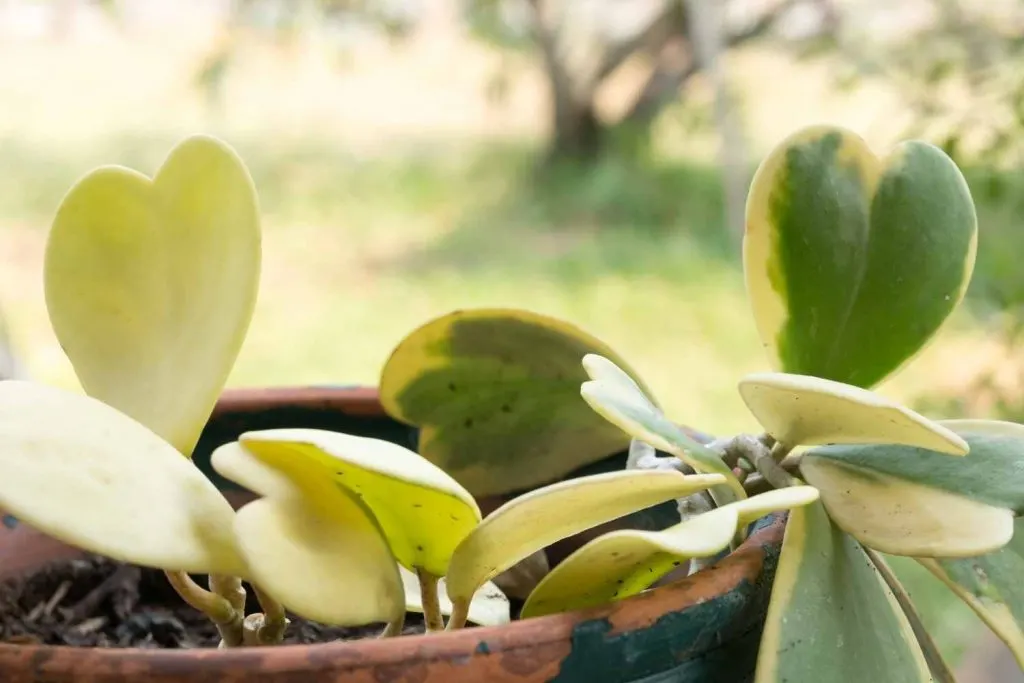
Follow Us:
Find us on YouTube, Instagram , Pinterest and TikTok! We love to Plant chat. We also comment, like and occasionally share your content to our daily stories. We’d love to see your plants. Share your joy in your houseplants. Happy Planting!
Recent Posts:
